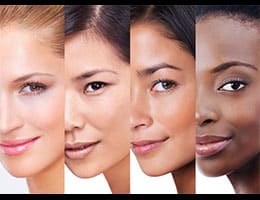 Melanin is a pigment that certain cells of vertebrate animals present in the cytoplasm. This substance, which appears in granules , has a blackish tone and gives color to hair, skin and other parts of the body.
Melanin is a pigment that certain cells of vertebrate animals present in the cytoplasm. This substance, which appears in granules , has a blackish tone and gives color to hair, skin and other parts of the body.
Melanogenesis is the process of melanin production. This action is carried out in the pilosebaceous follicle and in the epidermis as a response to ultraviolet radiation that affects DNA .
Melanin, in this framework, is responsible for absorbing harmful ultraviolet radiation and transforming it into heat (harmless). Thus it dissipates almost all of this radiation.
Melamine comes in two types:
* eumelamines : they contain sulfur and their color is brown or black, which is why they provide a dark color. They are the most common;
* pheomelamines : the color they provide is clear and they provide more sulfur than the previous ones. Its color is reddish or yellow.
When we are exposed to the sun, therefore, melamine protects us more or less effectively, depending on the individual. Eumelanin acts better than pheomelanin in these cases. The tan, so sought after by light- skinned people in hot weather, is nothing more than a defense mechanism of our skin, a pigmentation that results from adaptation to the sun's rays and that takes place thanks to the presence of melamine in the body.
In other words, the greater the pigmentation in the skin, the greater the protection against the damaging effects of sunlight. The ability to assimilate the sun's radiation is known as phototype , and is divided into five degrees according to the consequences of sun exposure, ranging from tanning to burns:
* phototype I : in this group are skins that can never tan, and that burn easily;
* phototype II : these skin types have difficulty tanning, although they can achieve it. However, they also burn;
* phototype III : they can burn, although not always. After a period of exposure to the sun 's rays, they tan;
* phototype IV : they never burn and can tan without problems;
* phototype V : constitutional pigmentation is moderate;
* phototype VI : constitutional pigmentation is intense. It's about black skin.
 Depending on genetic characteristics, human beings have a lower or higher level of melanin in their skin. The genetic disorder that causes the absence or reduction of this pigment is called albinism .
Depending on genetic characteristics, human beings have a lower or higher level of melanin in their skin. The genetic disorder that causes the absence or reduction of this pigment is called albinism .
Albinos, therefore, lack melanin or harbor a limited amount of this substance in their bodies. This condition affects people and animals.
As we age , the loss of melanin is natural in all individuals. When hair lacks pigment, for example, it turns white or gray and turns gray .
By losing melanin, in this way, the subject becomes gray. To delay this process, it is possible to follow a diet that, thanks to nutrients and vitamins, encourages pigment production. Vegetables, pumpkin, carrots and cherries are some of the foods that, according to experts, contribute to the production of melanin.
Within this framework, there are three substances that, according to experts, promote the production of melanin in our body . First of all we have carotenoids , pigments that all green plants contain. Beta-carotene , for its part, is the most sought after since it can protect the skin from redness and erythema caused by sun exposure. Finally we have the antioxidant called lycopene , which when combined with beta-carotene enhances its absorption.
